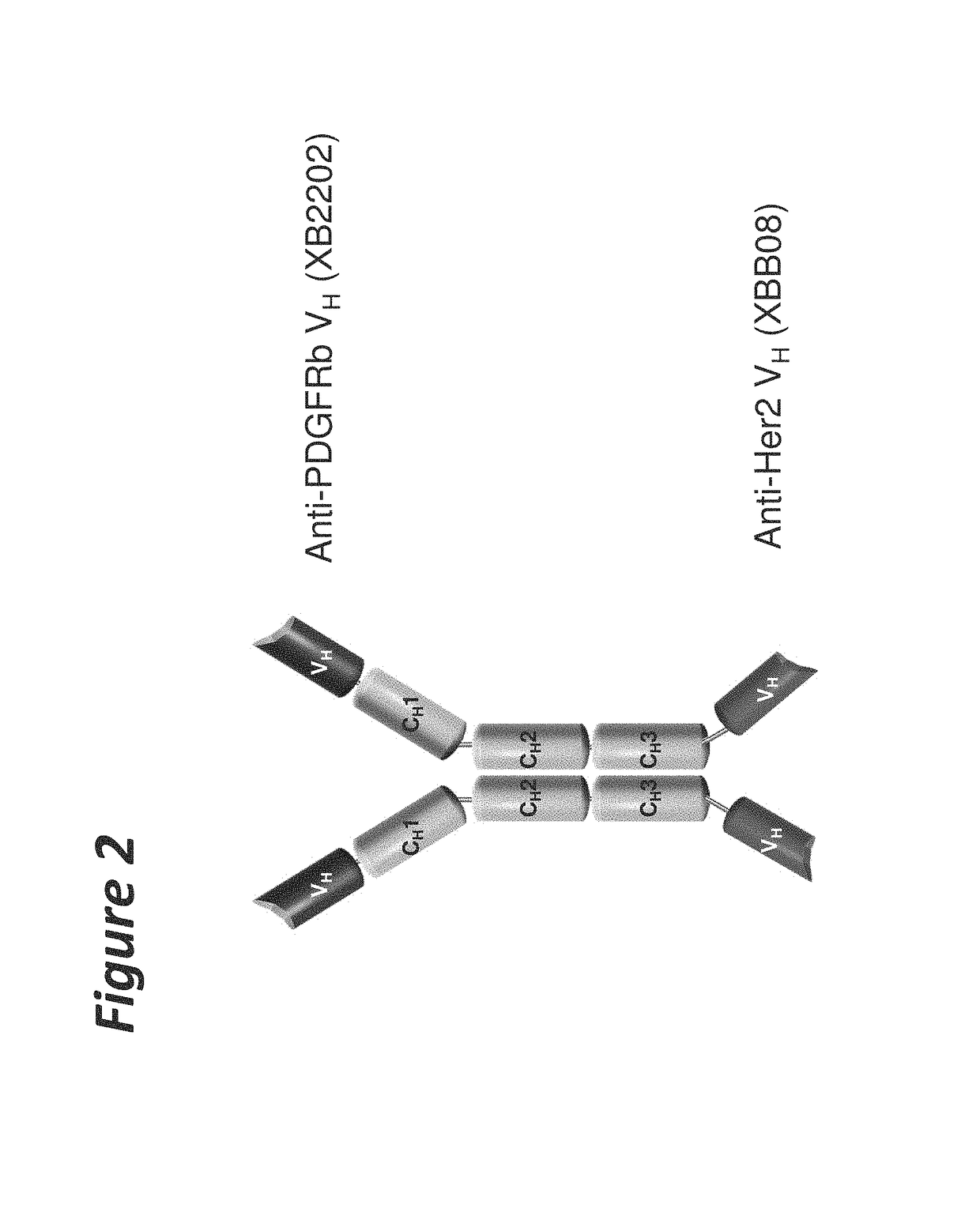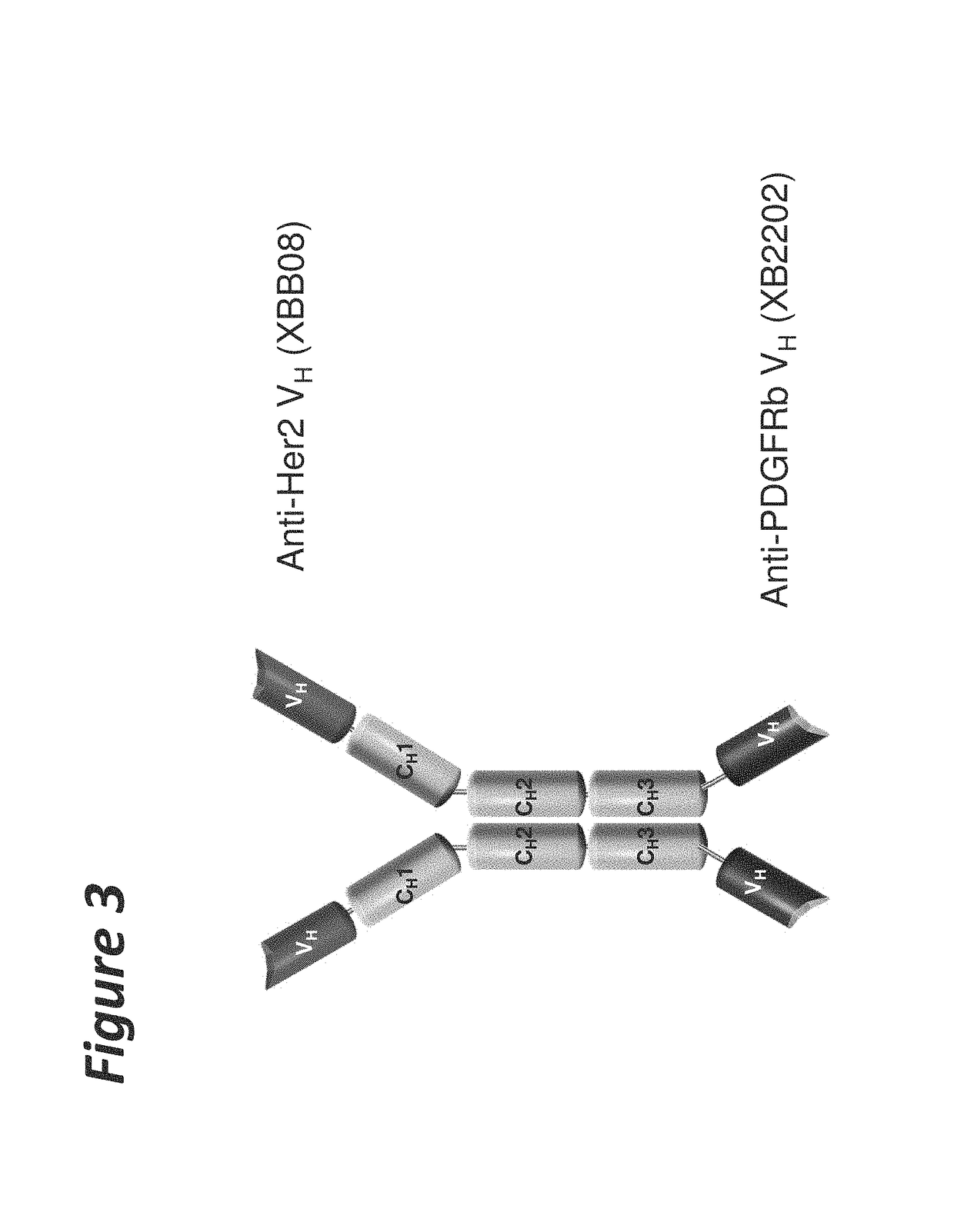Bi-specific antigen-binding polypeptides
a polypeptide and specific technology, applied in the field of bi-specific antigen-binding polypeptides, can solve the problems of reducing the yield of bi-specific antibodies, difficult purification, and difficult manufacturing of these molecules, and achieves high expression, easy purification, and stable
- Summary
- Abstract
- Description
- Claims
- Application Information
AI Technical Summary
Problems solved by technology
Method used
Image
Examples
example 1
Production of HER2 / PDGFRβ Bi-Specific Antigen-Binding Polypeptides
[0153]The genes coding for various HER2 / PDGFRβ bi-specific antigen-binding polypeptide formats were synthesized and cloned into mammalian expression vectors. The constructs were then transiently transfected into HEK293 cells following the standard protocol. The supernatant was harvested and tested for expression. An SDS-PAGE gel of an expressed dimer of bi-specific format 2 (SEQ ID No 18 in Table 4) is set forth in FIG. 5. The gel shows that under non-reducing conditions a polypeptide of the expected 125 Da is expressed (lane 2) and that this dissociates into monomers of the expected 62.5 kDa under reducing conditions (lane 1).
example 2
Assessment of HER2 / PDGFRβ Bi-Specific Antigen-Binding Polypeptide Expression Using ELISA
[0154]An ELISA assay was developed to assay the expression of the HER2 / PDGFRβ bi-specific antigen-binding polypeptides in cell supernatant. Briefly, 2 ug / mL of anti-human Fc antibody was captured on a Maxisorp Immulon plate overnight and blocked with superblock. The supernatant was serially diluted and loaded onto the plate. Culture media was similarly diluted and loaded in parallel as a negative control. The bi-specific antigen-binding polypeptide was detected with anti-human Fab specific HRP. The results set forth in FIG. 6 show that the ELISA assay is able to detect bi-specific antigen-binding polypeptide in HEK293 cell supernatant.
example 3
Detection of Simultaneous Antigen Binding of HER2 / PDGFRβ Bi-Specific Antigen-Binding Polypeptides Using ELISA
[0155]An ELISA assay was developed to detect the simultaneous binding of HER2 / PDGFRβ bi-specific antigen-binding polypeptides to HER2 and PDGFRβ. Briefly, 2 ug / mL of human Her2-Fc fusion protein (with no His epitope tag) was immobilized on a Maxisorp Immulon plate overnight and blocked with superblock. HEK293 cell supernatant containing a bi-specific antigen-binding polypeptide was serial diluted and loaded on the plate. After a one hour incubation, the plate was washed and 100 nM of human PDGFRβ-Fc fusion (with a His epitope tag) was applied to the plate and incubated for one hour. The binding of the bi-specific Ab to Her2 and PDGFRb was detected using an anti-His HRP. The results set forth in FIG. 7 show that the bi-specific antigen-binding polypeptide can simultaneously bind to both HER2 and PDGFRβ.
Example 4
FACS-based Binding Assay of HER2 / PDGFRβ Bi-Specific Antigen-Bindin...
PUM
| Property | Measurement | Unit |
|---|---|---|
| concentration | aaaaa | aaaaa |
| concentration | aaaaa | aaaaa |
| volume | aaaaa | aaaaa |
Abstract
Description
Claims
Application Information
 Login to View More
Login to View More - R&D
- Intellectual Property
- Life Sciences
- Materials
- Tech Scout
- Unparalleled Data Quality
- Higher Quality Content
- 60% Fewer Hallucinations
Browse by: Latest US Patents, China's latest patents, Technical Efficacy Thesaurus, Application Domain, Technology Topic, Popular Technical Reports.
© 2025 PatSnap. All rights reserved.Legal|Privacy policy|Modern Slavery Act Transparency Statement|Sitemap|About US| Contact US: help@patsnap.com



